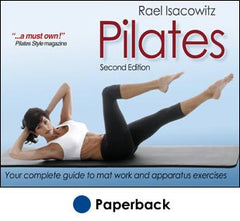Adapting Exercises
This is an excerpt from Pilates-2nd Edition by Rael Isacowitz.
There is no need to reinvent the wheel. I've seen people create variations of Pilates exercises simply to be different or to avoid boredom. Others choreograph variations because they are unfamiliar with the original exercises, or possibly cannot do them as prescribed. I do not support changing an exercise for any of these reasons. I believe the essence of the exercise is often lost in a mass of choreography, at times ceasing to have any resemblance to the original exercise or its intention. Yes, we must evolve. But evolution does not mean throwing out this vast, ingenious body of work. It means refining it according to advances in scientific knowledge and the needs of the individual - but always building on the foundation of the original work. The goal is to promote growth, keep the system alive and contemporary, and to adapt the work to individual and societal needs, while still preserving the legacy of Pilates.
The original body of work must be seen in the context of the time and place it was created, the early part of the 20th century in Europe and New York. That world was very different from the 21st century in terms of people's habits, occupations, and lifestyles. Computers were nonexistent, cars were scarce, air travel was a dream, the Internet was decades away, and recreational activities were simple and low-tech. Surely the evolution of this system and its adaptation to the needs of people today is justified and should be celebrated. But as we progress, we must not lose sight of the value of Joseph Pilates' work.
Modifying exercises is necessary at times in order to avoid negative movement patterns, compensations, and contraindications and to achieve the desired objectives. When I say modification, I mean changing the choreography of an exercise to meet certain goals. However, maintaining the essence of the exercise is critical, which means that one must understand the intention and mechanics of the exercise and its possible contraindications. Creating modifications is an integral part of being a creative, innovative, and interactive teacher.
This approach to modifications applies also to assists. Assists are external aids such as springs, rubber bands, cushions, balls, or adjustments to the apparatus that help achieve the goal. Again, complete understanding of the exercise and the exerciser is essential. Also important is being well informed about the many choices of apparatus and, which would be best suited for each scenario. In short, intimate familiarity with the Pilates repertoire, the human body and its movement, as well as the myriad choreographic directions and apparatus available make this work an evolutionary process.
In the first edition of Pilates I intentionally abstained from offering modifications and assists. Too much information and too many variations can lead to confusion. I wanted people to gain knowledge, understanding, and experience in the original repertoire. I also wanted to encourage individual creativity, which is a multiphase process. The first phase is learning the original exercises - their form, function, and intent. The second is gaining knowledge of the equipment as well as an understanding of anatomy, physiology, and kinesiology. and the final and most important is acknowledging the body you are working with - the possibilities for developing variations become infinite.
Following many requests from students and readers that I offer variations of exercises, I have included modification options for many of the exercises in this second edition of Pilates. My intention is to spark ideas. I stress that each person is an individual with particular needs, restrictions, and personal goals that must be taken into account when selecting or choreographing a variation of an exercise. Body type, suitability of apparatus, and desired outcome must also be considered. Finally, safety is always an underlying concern. Choose or create movements that will allow you and your student to perform the work safely and to enjoy years of Pilates practice.
Learn more about Pilates, Second Edition.
More Excerpts From Pilates 2nd Edition

Get the latest insights with regular newsletters, plus periodic product information and special insider offers.
JOIN NOW


